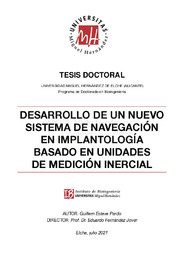Please use this identifier to cite or link to this item:
https://hdl.handle.net/11000/28957Desarrollo de un nuevo sistema de navegación en Implantología basado en unidades de medición inercial
| Title: Desarrollo de un nuevo sistema de navegación en Implantología basado en unidades de medición inercial |
| Authors: Esteve-Pardo, Guillem |
| Tutor: Fernández Jover, Eduardo |
| Editor: Universidad Miguel Hernández de Elche |
| Department: Instituto de Bioingeniería |
| Issue Date: 2021-07-21 |
| URI: https://hdl.handle.net/11000/28957 |
| Abstract: La colocación de implantes dentales mediante cirugía guiada por ordenador tiene numerosas ventajas frente a la realizada a mano alzada, especialmente mayor precisión, mayor seguridad y menor invasividad. Pero también, tanto los sistemas estáticos o férulas, como los dinámicos o navegación, presentan dificultades de uso y un mayor coste, por lo que su utilización actual es limitada. Se elabora una revisión de los distintos sistemas de guiado de la cirugía de colocación de implantes, de su uso, precisión y fuentes de error. Describimos la unidad de medición inercial o IMU y sus primeras aplicaciones en cirugía general, como una alternativa versátil, simple y económica a las tecnologías existentes. Por medio de un prototipo que integra los sensores IMU en una interfaz computerizada, se colocan implantes guiados por estos sensores, y también por férulas CAD-CAM. Los resultados medios comparados que obtenemos entre ambos sistemas de guiado, son similares estadísticamente. Las desviaciones medias han sido en coronal 1.48 ± 0.2 (SD 0.58; 95% CI 1.27 - 1.69) y 1.42 ± 0.2 (SD 0.61; 95% CI 1.2 - 1.64) mm, en apical 2.00 ± 0.33 (SD 0.93; 95% CI 1.67 - 2.33) y 2.07 ± 0.35 (SD 0.97; 95% CI 1.72 - 2.42) mm, y las angulares 7.13º ± 1.47º (SD 4.1; 95% CI 5.66 - 8.6) y 5.63º ± 1.41º (SD 3.94; 95% CI 4.22 - 7.04), para IMU y Férulas Estereolitográficas (FE) respectivamente. Estos resultados son consistentes con la precisión reportada en la literatura para la cirugía guiada, tanto estática como dinámica. Se valora igualmente la percepción del operador y su comodidad de uso, encontrando que el manejo del sistema requiere un entrenamiento previo y que se facilitaría al mejorar la interfaz gráfica. Se abre así una vía de investigación para adaptar este nuevo sistema de navegación al uso clínico rutinario. Para ello, es necesaria la mejora in vitro de sus condiciones de manejo, así como ulteriores estudios sobre pacientes. Computer-guided dental implant placement is considered to be safer, more accurate and less invasive compared to freehand implant surgery. Currently two types of surgical guiding systems are available, static templates and dynamic navigation. Both make intervention more complex and costly and this could be the reason why their current use remains limited. A "state of the art" of the different implant placement guiding systems, their use, precision and sources of error has been conducted. The Inertial Measurement Unit (IMU) and its early applications in general surgery are described. The IMU was shown to be a versatile, simple and economical alternative to existing surgical guidance technologies. A prototype surgical handpiece was assembled with IMU sensors integrated with a computerized interface to guide implant placement. Implants were placed in models using this prototype and the standard CAD-CAM splints. Similar statistical average results were obtained using either of the two systems. The mean deviations were 1.48 ± 0.2 (SD 0.58; 95% CI 1.27 - 1.69) and 1.42 ± 0.2 (SD 0.61; 95% CI 1.2 - 1.64) mm coronal, 2.00 ± 0.33 (SD 0.93; 95% CI 1.67 - 2.33) and 2.07 ± 0.35 (SD 0.97; 95% CI 1.72 - 2.42) mm apical, and 7.13º ± 1.47º (SD 4.1; 95% CI 5.66 - 8.6) y 5.63º ± 1.41º (SD 3.94; 95% CI 4.22 - 7.04) angular, for IMU’s and splints respectively. These results are consistent with the precision reported in the literature for guided surgery, both current static and dynamic modalities. When operator’s perceptions and comfort of use were addressed, it was found that the system’s handling requires going through a learning curve and that it would be facilitated by improving the graphic interface. The present study opens a path of investigation to adapt this new surgical navigation system to routine clinical use. To this end, the system has to be improved to make the operator’s control easier before further studies on patients can be carried out. |
| Keywords/Subjects: Biomedicina Ciencias médicas Estomatología Ortodoncia Cirugía maxilofacial Cirugía ósea |
| Knowledge area: CDU: Ciencias puras y naturales: Biología CDU: Ciencias aplicadas: Ingeniería. Tecnología |
| Type of document: application/pdf |
| Access rights: info:eu-repo/semantics/openAccess Attribution-NonCommercial-NoDerivatives 4.0 Internacional |
| Appears in Collections: Tesis doctorales - Ciencias e Ingenierías |
.png)

